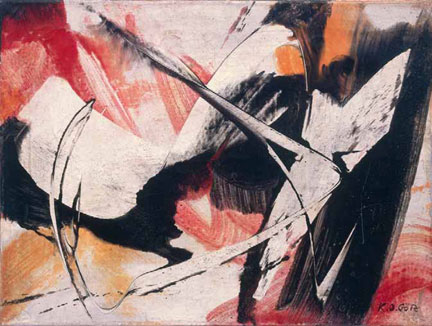K. O. Götz, Jan 1955, 1955

Karl Otto Götz, the only German member of the international COBRA group, was one of the few artists who attempted to provide theoretical underpinning and gain public attention for the abstract gestural painting of the post-war period: he co-published the magazine "Meta" from 1948 to 1953, was a founding member of the Frankfurt Quadriga group of artists and published texts on cognitive psychology. It was from his study of Surrealist methods that Götz developed his own specific technique involving the use of distemper, broad brushes and a rake-spatula. This technique was instrumental to achieving changes of form and content using pictorial and scriptorial methods. Götz, an unwavering opponent of geometric abstraction, developed a style that was powerful, emotional and mould-breaking.
Both the temporal and spatial dimensions of his art are clearly evident in his work "Jan 1955". In the first painting stage, various colours are splashed onto the paper and daubed across the whole surface; then this static arrangement is scratched and scraped into a spatial event through vigorous application of a rake. The white ‘negative’ lines gouged out of the previously created colours and shapes add a dynamic and dramatic dimension. It is no longer possible to distinguish between foreground and background or positive and negative. The picture itself becomes a visual experience.